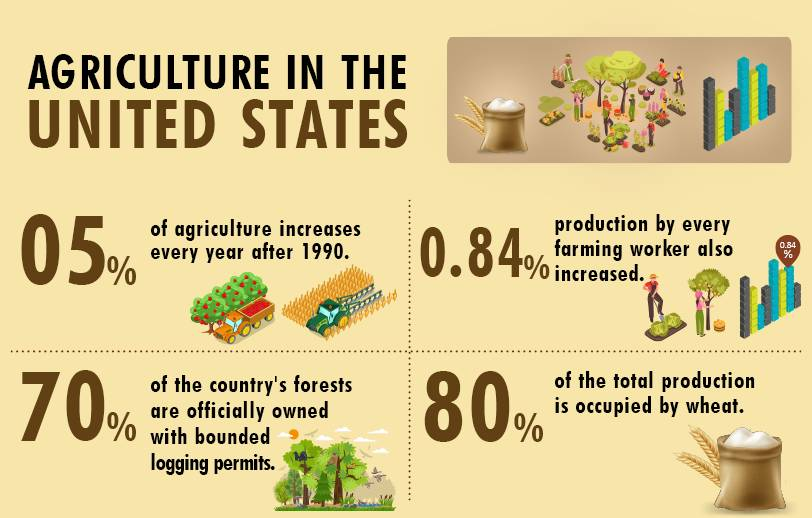Do You Know: Who Produces the World's Food?
Feb 11, 2024 By Triston Martin
Introduction
Ever thought: who produces the world's food? There isn't a single food item that the entire world consumes. The most fundamental food ingredients are the same, even though the food and flavours in various parts of the world differ, and numerous businesses have patents for particular plant species. We can consider rice, wheat, maize (corn), and sugarcane as the most basic foods and the top five most used commodities in the world based on the demand-supply relationship.
Staple Food Production
Wheat
Wheat is an adaptable plant that easily thrives in warm climates, and it was first domesticated in the Middle East. Usually, the wheat is ground into flour, which is then used to make biscuits, pasta noodles, and other commonly eaten foods. 2019, nearly 31% of the world's wheat production came from China and India. Russia, America, France, and other countries produce less of the crop, though still in significant amounts.
Rice
9400 years ago, hunter-gatherers in China started growing rice near the Yangtze River. More than 3.5 billion people, largely in Asia, depend on this crop, which is currently the third-highest producer in the world. The countries with the highest populations also produce the most rice is not surprising. Furthermore, Asia is home to 9 of the top 10 producers of rice, demonstrating the food's significance to people living in the region.
Maize
The most widely grown crop in the Americas, maize is used in many industries. The crop is native to Central America but is also farmed widely elsewhere. With considerable volumes of maize coming from the States of Iowa, Illinois, and Nebraska, the United States is by far the largest corn producer and exporter. Corn is grown on over 90 million acres of land, an area roughly equivalent to Montana. The United States follows China, the second-largest producer and consumer of maize, as the biggest user of corn.
Top 5 Food-Producing Countries
United States
It is the only nation with a smaller population than China that produces food as efficiently as the U.S., and the quality of all U.S. agricultural output is very similar. Even though food is produced across the country, California, Iowa, Texas, Nebraska, and Illinois are the states with the highest food production rates.

Russia
13 percent of Russia's land is under cultivation to grow potatoes and sugar beets. The three main kinds of cereal are corn, rye, and barley. Russia has significant agricultural industry and primarily engages in industrial activity. About 6% of the Russian GDP is derived from agriculture. Accordingly, 16% of the country's employment prospects are provided by the agricultural sector in Russia.
China
Due to its extensive manufacturing industry, China is frequently referred to as the "world's factory." Contrarily, it is also the greatest agricultural economy in the world. Even though it has decreased significantly over the last two to three decades, the agricultural sector's share of the GDP has remained constant at 10% over the past ten years. About one-third of China's workforce is employed in the agricultural industry. China is undoubtedly the largest producer of grains, rice, and potatoes in the world. It is also the third-largest producer of sugarcane and the second-largest producer of maize, respectively.
India
India is the second-largest food producer in the world in terms of the total number of calories consumed. India falls fourth in terms of the value of its total agricultural manufacturing output and can only produce half as much as China. The efficiency of the farm is also much lower in India than in China, the United States, or Brazil.
Brazil
Brazil is the world's largest producer of sugarcane, coffee, beef, soybeans, maize, and sugarcane. It is also the third-largest producer of rice and the ninth-largest producer of maize. Brazil's economy has historically been regarded as one of the top agricultural countries. Brazil's farmers use about 41 percent of the country's agricultural land area. Brazil has 2.1 billion acres of land area. In Brazil, there are also about 867.4 million acres that are used for agriculture. Sugarcane was Brazil's leading agricultural product. About 12,000 years ago, Brazilians started farming their land. They raised various crops, including tobacco, sweet potatoes, peanuts, and sweet maize.
Conclusion

According to a study on producing five of the most popular commodities, their rankings have remained stable for the last 5 years. With a consistent production rate over time, potatoes, wheat, and rice have remained in positions 4, 3, and 5, respectively. Except for the past year, when it exploded in production, going from 877 million tonnes to one billion tonnes, maize production has been relatively stable. The sugarcane commodity has seen an increase in output to 1.9 billion tonnes, far exceeding that of other items.





